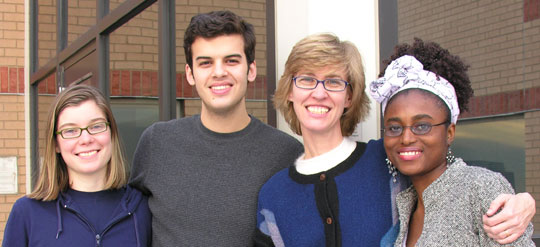About the AAAH

History of the AAAH
Development of the AAAH began in the summer of 2004 as part of the Instructional Technology Group’s Summer Institute, which provides grants for the development of curricular materials for instructional purposes. As a participant in the Summer Institute, Professor Nancy Jacobs proposed a computer animation to supplement other materials in her course Africana Studies 16, “Twentieth-Century Africa.” Working with Professor Jacobs, Rolando Peñate (Brown ’06) a member of the Brown CIS STA Program, designed and developed the project. In the fall of 2004, the AAAH was positively received by students in AF16 and helped garner Professor Jacobs a “Best of WebCT” award. Building on the success of the AAAH in AF16 and with further support from the ITG, we have continued to expand upon and improve it in 2005 and 2006.
Design of the AAAH
Designing the AAAH required AAAH required Mr. Peñate to integrate many qualitatively different types of data in a way that could be easily grasped by an uninstructed user.
Appearance
The interface for the AAAH is straightforward. The map displays information in several ways: color-coding of territories reflects political changes; symbols show conflicts as isolated events; bar graphs give demographic and economic data, and labels show country names. Users may click on the diamonds in the bottom center to reveal or hide these features. Timeline controls on the bottom-right advance or reverse the chronology. The polygonal keys expand when the mouse is placed over them and can be dragged to any location on the map to match colors with those on the key. For the period after 1960, the labels also contain bar graphs showing changes in population and per capita GDP over time.
Structure
To maximize the availability of the tool and allow for future expansion, the AAAH was constructed using Macromedia Flash, the de facto standard for internet-based multimedia. Despite appearances the AAAH is not one animated atlas but actually several individual sequences (color-coded political changes, war symbols, demographic bars, etc.) synchronized and controlled to provide a seamless user experience. This division benefits the user by allowing different information to be toggled and benefits the designers by allowing future expansion.
“Team AAAH”

Left to right: Meghan Gill (Brown ’06), Rolando Peņate (Brown ’06), Professor Nancy Jacobs, Dzigbodi Agbenyadzie (Brown ’08)
Acknowledgements
Research Assistance from:
- Dzigbodi Agbenyadzie (Brown ’08)
- UTRA Researcher, Brown University
- Meghan Gill (Brown ’06)
- UTRA Researcher, Brown University
Additional Assistance from:
- Stephanie Birdsall
- Instructional Technologist, Brown University ITG
- Ryan Chan (Brown ’10)
- Student Technology Assistant, Brown University STA Program Jihan Chao (Brown ’10)
- Student Technology Assistant, Brown University STA Program
- Michael Cohen
- Educational Computing Specialist, Brown University TLS
- Judy He (Brown ’07)
- Student Technology Assistant, Brown University STA Program
- Siobhan Ross
- Instructional Technologist, Brown University ITG
- Giovanna (Giovi) Roz
- STA Program Coordinator, Brown University STA Program
- Joaquín de Salas Vara de Rey
- “Historical and Political Maps of Africa”
- Michelle Thacher
- Instructional Technologist, Brown University ITG
- Pat Zudeck
- Senior Instructional Technologist, Brown University ITG
 © 2004-2008 Nancy Jacobs and Rolando Peñate.
© 2004-2008 Nancy Jacobs and Rolando Peñate.This work is licensed under a Creative Commons License.